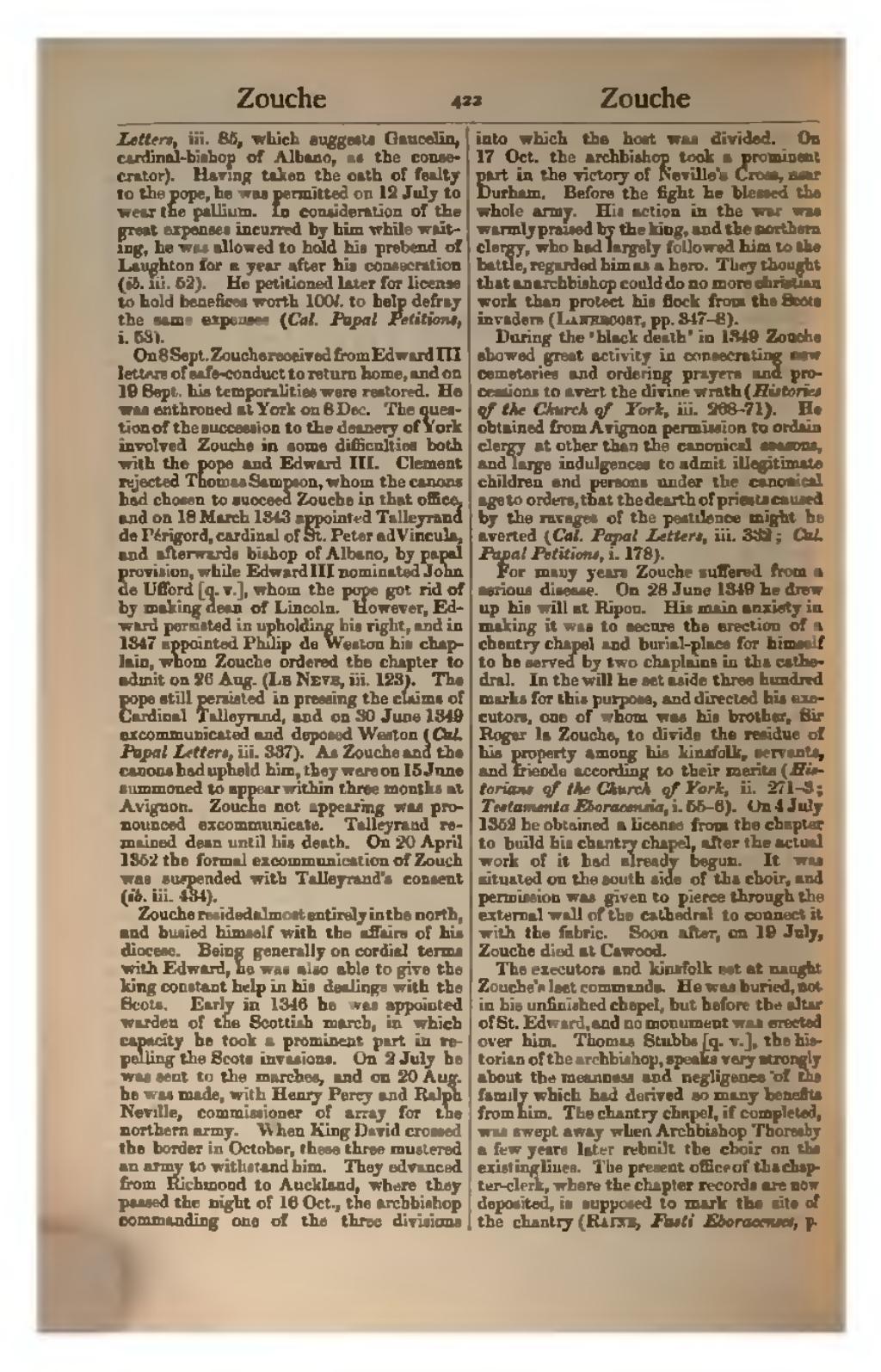Letters, iii. 85, which suggests Gaucelin, cardinal-bishop of Albano, as the consecrator). Having taken the oath of fealty to the pope, he was permitted on 12 July to wear the pallium. In consideration of the great expenses incurred by him while waiting, he was allowed to hold his prebend of Laughton for a year after his consecration (ib. iii. 52). He petitioned later for license to hold benefices worth 100l. to help defray the same expenses (Cal. Papal Petitions, i. 53).
On 8 Sept. Zouche received from Edward III letters of safe-conduct to return home, and on 19 Sept. his temporalities were restored. He was enthroned at York on 8 Dec. The question of the succession to the deanery of York involved Zouche in some difficulties both with the pope and Edward III. Clement rejected Thomas Sampson, whom the canons had chosen to succeed Zouche in that office, and on 18 March 1343 appointed Talleyrand de Périgord, cardinal of St. Peter ad Vincula, and afterwards bishop of Albano, by papal provision, while Edward III nominated John de Ufford [q. v.], whom the pope got rid of by making dean of Lincoln. However, Edward persisted in upholding his right, and in 1347 appointed Philip de Weston his chaplain, whom Zouche ordered the chapter to admit on 26 Aug. (Le Neve, iii. 123). The pope still persisted in pressing the claims of Cardinal Talleyrand, and on 30 June 1349 excommunicated and deposed Weston (Cal. Papal Letters, iii. 337). As Zouche and the canons had upheld him, they were on 15 June summoned to appear within three months at Avignon. Zouche not appearing was pronounced excommunicate. Talleyrand remained dean until his death. On 20 April 1352 the formal excommunication of Zouch was suspended with Talleyrand's consent (ib. iii. 434).
Zouche resided almost entirely in the north, and busied himself with the affairs of his diocese. Being generally on cordial terms with Edward, he was also able to give the king constant help in his dealings with the Scots. Early in 1346 he was appointed warden of the Scottish march, in which capacity he took a prominent part in repelling the Scots invasions. On 2 July he was sent to the marches, and on 20 Aug. he was made, with Henry Percy and Ralph Neville, commissioner of array for the northern army. When King David crossed the border in October, these three mustered an army to withstand him. They advanced from Richmond to Auckland, where they passed the night of 16 Oct., the archbishop commanding one of the three divisions into which the host was divided. On 17 Oct. the archbishop took a prominent part in the victory of Neville's Cross, near Durham. Before the fight he blessed the whole army. His action in the war was warmly praised by the king, and the northern clergy, who had largely followed him to the battle, regarded him as a hero. They thought that an archbishop could do no more christian work than protect his flock from the Scots invaders (Lanercost, pp. 347–8).
During the ‘black death’ in 1349 Zouche showed great activity in consecrating new cemeteries and ordering prayers and processions to avert the divine wrath (Historians of the Church of York, iii. 268–71). He obtained from Avignon permission to ordain clergy at other than the canonical seasons, and large indulgences to admit illegitimate children and persons under the canonical age to orders, that the dearth of priests caused by the ravages of the pestilence might be averted (Cal. Papal Letters, iii. 332; Cal. Papal Petitions, i. 178).
For many years Zouche suffered from a serious disease. On 28 June 1349 he drew up his will at Ripon. His main anxiety in making it was to secure the erection of a chantry chapel and burial-place for himself to be served by two chaplains in the cathedral. In the will he set aside three hundred marks for this purpose, and directed his executors, one of whom was his brother, Sir Roger la Zouche, to divide the residue of his property among his kinsfolk, servants, and friends according to their merits (Historians of the Church of York, ii. 271–3; Testamenta Eboracensia, i. 55–6). On 4 July 1352 he obtained a license from the chapter to build his chantry chapel, after the actual work of it had already begun. It was situated on the south side of the choir, and permission was given to pierce through the external wall of the cathedral to connect it with the fabric. Soon after, on 19 July, Zouche died at Cawood.
The executors and kinsfolk set at naught Zouche's last commands. He was buried, not in his unfinished chapel, but before the altar of St. Edward, and no monument was erected over him. Thomas Stubbs [q. v.], the historian of the archbishop, speaks very strongly about the meanness and negligence of the family which had derived so many benefits from him. The chantry chapel, if completed, was swept away when Archbishop Thoresby a few years later rebuilt the choir on the existing lines. The present office of the chapter-clerk, where the chapter records are now deposited, is supposed to mark the site of the chantry (Raine, Fasti Eboracenses, p.
